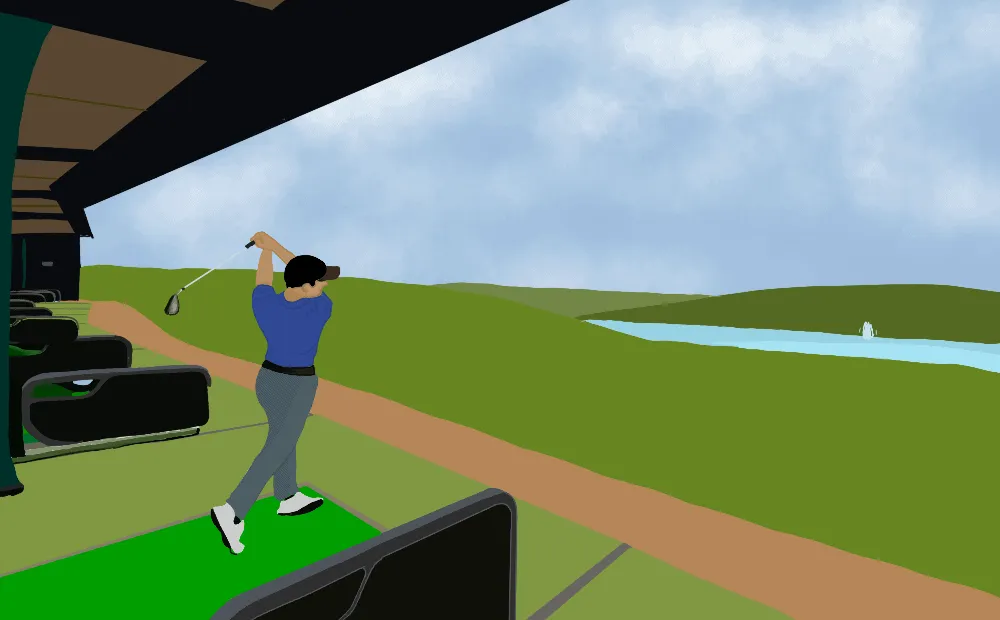
Here are my top 11 driving range tips for beginners and golfers of all skill-level.
It sucks when you’ve got no clue where to start when you’re at the driving range (trust me I’ve been there). The worst part is, this is where most beginners quit when they get bored or get embarrassed stepping onto the practice range for the first time.
Here, I’m welcoming all beginners by introducing my 11 best driving range tips for beginners that made me reach Scratch in golf.
This guide is designed to eliminate all feelings of anxiousness when at the driving range and teach beginner golfers how to practice effectively to sharpen their skills instead of wasting their time like the majority of amateur and recreational players. In addition, we include helpful tips to aid beginners in avoiding the most common mistakes we see newcomers make.
Be sure to stick around until the end of our guide where we discuss a few of our favorite driving range drills that have helped keep our skills sharp for years!
Remember to share these awesome tips with your friends!
Table of Contents
could you take a single club to the driving range?
Yes. No hitting range that I know of has a limitation or requirement to the number of golf clubs you can/ should bring to use their facility. Feel free to bring any club to the range. However, I would suggest carrying at least three to four clubs with you.
Do Driving Ranges Provide Clubs?
Most driving ranges do borrow clubs, but they’re only really for newcomers looking to try golf out for the first time. Plus, they come with a fee! If you’re ready to start hitting the ranges every day, we encourage buy your own set of golf clubs suited for beginners. For female beginners, check here: 5 Best Women’s Golf Clubs For Beginners.
How To Practice at the driving range?
Always practice with an objective and plan in mind. Start by stretching your arms, legs, and hips. Work with the drills we listed below and follow carefully the 11 driving tips we’re about to show you.
11 Crucial Driving Range Tips For Beginners
As experienced players and golf instructors here at Golf Leap, we understand the driving range can be an anxiety-inducing place for beginners. You’ll often hear players hitting balls and expressing frustration with mis-hits, making newbies think flushing every shot is the goal of the range when nothing could be further from the truth.
Not to mention when you dink a ball toward the ceiling, echoing your mistake to every golfer in that range. What do you do from there? Leave? Change your club? Check out rule #11.
That said, we believe the overarching mission of the driving range should be to get 1% better at an aspect of your game, with absolutely ZERO stress. We use the driving range as a place to work on our craft and relax, saving the nerves for actual competition on the golf course.
Where is a Golf Driving Range Near me?
We aren’t affiliates of Top Golf, but I remember bringing a beginner buddy of mine to Top Golf, and boy did he get hooked! Trying to have fun while practicing as a beginner can be hard sometimes and I honestly believe Top Golf does a great job of taking the stress off of learning the game. Here are some areas you may find Top Golf Ranges Near You in the US.
Rule #1 – Get Alignment Sticks
There’s a reason 99% of PGA Tour-level golfers carry alignment sticks in their golf bags. Players of every skill level use alignment stick as added tools to enhance their practice at the driving range.
The obvious reason to carry alignment sticks is, you guessed it, to make sure your alignment stays top-notch so you can aim at your intended targets once on the golf course.
Beginners should start using alignment sticks by placing one between themselves and the ball, pointed towards their target. When addressing the golf ball, imagine an alignment line across your toes, knees, and shoulders. Do they all point in a straight line, parallel to your alignment stick on the ground? If not, we’ve got an issue here.
We’ll expand on our favorite driving range drills that use alignment sticks later, but the first step to proper practice is having the right tools in your toolbox!
We Recommend: GoSports Golf Alignment Training Sticks 3 Pack
- Bang for Your Buck
- 48″ long and foldable
- One-end pointed tips for easy ground stacking
- Best Seller on Amazon
Rule #2 – Warm-Up Your Body With Stretches (Warm-Up 1)
Even though golf has had a misleading reputation for a while as “a lazy man’s game,” it’s starting to become known as one of the more injury-inducing sports young people play.
The golf swing involves a crazy amount of twisting, which results in forceful torque being put on golfers’ joints and muscles.
To combat these unfortunate facts about golf, we don’t hit a ball before we stretch first.
Not only does stretching for a few minutes lower a golfer’s risk of injury or muscle tear, but it also lowers the heart rate and calms the mind before practice begins, creating a perfect work environment for effective range time.
Rule #3 – Define Your Goals and Intentions
The most common mistake we see amateurs and recreational golfers make at the driving range is taking swing after swing with little to no “reset” (we’ll touch on what that is later) or real intention behind their swings.
While you’re loosening up your muscles and joints following Rule #2, you should be thinking about what you’re looking to focus on during your time spent at the range. Many beginner golfers don’t have endless hours to spend at the driving range, so defining what you’re working to accomplish is important.
An example of a “focus” for a range session could be, “I want to dial in my wedge yardages, make sure my iron swing feels good, and work on driver accuracy to end.”
Defining these goals for your range session can let you plan how much time you have to spend on each aspect of your practice and gives you trackable markers to evaluate your performance against so you can monitor your progress from range time to range time.
Rule #4 – Place Your Range Balls and Clubs Out Of Reach
To help avoid the most common mistake most recreational golfers make (rocketing ball after ball without any intention) and look like you know what you’re doing at the same time, place your range balls and clubs just out of reach of where you’re swinging.
Dumping out your range balls and having your clubs a quick grasp away leads to hurried and useless practice.
By keeping your clubs away from you and only grabbing 2-4 range balls at a time from your purchased bucket/bag, you slow down your practice sessions, enhance your focus, and allow sufficient recovery time before swings.
Do you ever make two or three swings in one minute on the golf course? Then why would you practice that way?
By pausing your practice momentarily to grab more range balls from your supply, you’re forcing your body and mind to “reset.” These small breaks can also force beginners to work on their “pre-shot routine” more similarly to how it feels on the golf course.
Rule #5 – Your First 3 to 5 Swings (Warm-Up Number 2)
Another critical mistake we see beginner golfers make is thinking the first few swings of a practice session will determine how the rest of their practice or upcoming round will go.
Your first few swings should serve as a time to re-accompany your body and hands to your golf club and are no indication as to how you will perform that day.
We like to start by taking a few 50% speed practice swings with our lob or sand wedge, then hitting a few balls at this same speed and tempo to ease our body and mind back into the golf swing motion.
We don’t care where these balls are going, just that we are making solid contact with the golf ball and loosening up our body at the same time.
You’ve now completed roughly 10 swings (with practice swings and half-hearted wedge shots included), and you’re ready for rule #6.
Rule #6 – Have a Target on Every Swing Post-Warm Ups
Now that your body and swing are fully warmed up, you should have an intended target with every swing.
Most driving ranges have flags or objects at specific yardages to indicate to golfers how far each ball is going.
We only have limited range balls, so having a target, for example, “I want to be within 5 yards of the 100-yard flag.” allows a golfer to evaluate their performance once they feel it is time to move to the next club.
“I hit 5 out of 10 of my range balls outside of my intended 5-yard circle around the 100-yard flag.” This would indicate to a player that their performance in this category needs to improve, and they should strive for 6+ shots in this range for measurable improvement the next time they try this target.
Rule #7 – Clean Your Grooves Religiously
Every golfer needs to have a brush of some type on or in their golf bag to clean their grooves and club heads. Period! The sooner you begin the habit of cleaning your grooves regularly, the better.
If we had a dollar for every time we saw a golfer with dirty grooves on the driving range that is sure to impact the performance of their club, we’d be rich!
After going to professional golf events over the years and watching how the pros practice, we noticed they clean their grooves after every single shot.
Think about it, the club engineers don’t design the club to be dirty to perform its best, so why would you use it that way?
Cleaning your grooves and wiping them with your towel also slows down your practice, forces more mini “resets,” and makes sure you are getting the most accurate swing results/feedback per range ball.
The good news is, golf club grooves sharpeners/ cleaners are extremely affordable and handy! So we’d highly suggest getting one. We’ve covered our top picks for these sharpeners here: 5 Best Golf Club Groover Sharpeners.
Rule #8 – You DON’T Have to Hit Every Club at the Range
A misunderstanding many beginners have is that every club needs to be “checked” or swung a few times at the range to make sure it’s still in working order.
In actuality, beginner golfers can make the most of their practice time by focusing their effort on fewer clubs in the bag. For example, a wise use of 60 range balls could look like “15 Wedge Shots, 15 Eight Iron Shots, 15 Six Iron Shots, 8 Fairway Wood Swings, 7 Driver Swings.”
Sure, you’re not hitting every club, but if you can effectively practice your 8 iron, you can believe that same practice is translating to your 9 and 7-irons as well. The same principle applies to your 6 iron and its surrounding clubs.
If you play a round and everything went well except for one practicable aspect of your game, focus on it heavier during your range time and allocate golf balls accordingly.
Rule #9 – Film Your Swing Regularly During Practices
Take your phone or have a friend grab some videos of your swing from different angles. There are endless resources online to compare your swing to, coaches like swing videos for golfer-specific learning purposes, and this is another way to measure your progression of golf skills as you play the game.
Additionally, when your swing feels awry you’ll now have a customized resource you can look at to remind you what your swing looks and feels like when things are going great.
Rule #10 – Experiment to Learn What Drills Work Best For Your Game
Besides placing an alignment stick at your feet to check your general swing alignment, there are quite literally endless driving range drills for you to explore and experiment with as a beginner golfer.
You never know when something is going to “click” about your swing at the driving range, but experimenting with different drills and “feels” (trying to achieve different feelings of motion in your swing, a.k.a doing an explained motion) and seeing what works is how you get better as a beginner golfer.
Rule #11 – Don’t Shy Away from Mishits!
Here’s a little rule/ tip to ease off the nerves a little when you’re on the range, which ultimately will make you have more fun and play better golf. And that is, don’t shy away from mishits or bad shots!
If you’re hitting ridiculous slices, thinning the ball, etc. Should you be leaving the range? Sadly, there are some golfers who do this. And here’s what I have to say.
“If you’re causing any danger or being too much of a distraction to other golfers, then keep going. In fact, every player there would understand that you’re still learning!”
Our 3 Favorite Driving Range Drills
While we don’t have the time to go over every drill imaginable, we will give beginner golfers our three favorite driving range drills that keep our golf game in check.
Drill #1: Feet and Center Alignment Drill
Using the alignment sticks you hopefully acquired after reading Rule #1, place one at your feet pointed toward your intended target and one perpendicular through its center, placing your feet on either side.
Using the perpendicular alignment stick as your guide to “center,” begin hitting balls from this position and commit this position to memory.

Most of your swings will operate off of the “center” of your stance, with wedges moving slightly back of center and lower lofted clubs moving more towards players leading side of center.
Knowing how to find the center of your stance is one of the skills that separates a beginner golfer and a true player!
Drill #2: Train Tracks Drill
The “Train Tracks” drill uses an alignment stick at your feet and an alignment stick on the outside of your club path towards the golf ball.
This drill not only keeps your club path from moving too far inside to out but also trains your eyes and body to align parallel to your target, making the transition to proper aiming on the golf course easier after practice.
Drill #3: The Goal Post Drill
By placing a few alignment sticks in the ground 5-10 yards in front of your hitting area and between you and your intended target, you are effectively bringing your target closer to you for more precise and instantaneous feedback.
For example, if your tendency is to push the ball towards your dominant side, work on beginning your ball flight towards your non-dominant side and receive immediate feedback by watching where your ball passes through the “goal-post” you’ve created with your alignment sticks.
The Verdict and What Next?
Take these driving range tips into your practice. I’d suggest pulling this list up during your practice and trying to adapt each one at a time. Really focus on drilling these tips into your range practices for the first year with the goal of jumping into the golf course as soon as possible! Good luck!
While you’re here, be sure to check out some of our other breakdowns that are guaranteed to help every beginner golfer at the range:


